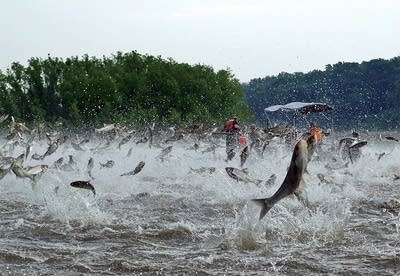Scientists to test water 'gun' in Asian carp fight
Go Deeper.
Create an account or log in to save stories.
Like this?
Thanks for liking this story! We have added it to a list of your favorite stories.

A "gun" that shoots powerful pulses of water might be used to keep Asian carp from slipping into Lake Michigan near a Chicago shipping lock if testing this summer determines it wouldn't damage the structure, an official from the U.S Geological Survey said Thursday.
The water cannon, which creates enough energy to deter or kill fish, could be positioned near the lock, the point where some fear the invasive carp could get into the lake if the fish somehow got through electrical barriers already operating in canals farther inland, said Leon M. Carl, USGS regional executive.
"My guess is that this would stop them ... and that would be to me something that we'd really like to have in place," Carl told The Associated Press after a public hearing, calling the water guns an "urgent" measure to deter and control the carp.
Right now, three electrical barriers sending pulses through shipping canals west of Chicago are the only things stopping the carp from reaching Lake Michigan, where biologists fear the voracious fish could disrupt the food web by outcompeting less aggressive fish for plankton and eventually threaten the Great Lakes' $7 billion fishing industry. The carp can grow to 4 feet in length and weigh up to 100 pounds.
Turn Up Your Support
MPR News helps you turn down the noise and build shared understanding. Turn up your support for this public resource and keep trusted journalism accessible to all.
Asian bighead and silver carp were introduced in the South and have been making their way north for decades. They're now just miles from Lake Michigan, in a network of manmade canals engineered over 100 years ago to reverse the flow of the Chicago River and create a link between the Great Lakes and Mississippi River watersheds.
The USGS also is researching the use of pheromones that could attract the carp to one area, continuous sonar to deter them and a possible chemical control specific to the carp, Carl said.
But environmental groups say such measures, while they could help buy some time, are not a permanent solution, and they have urged the U.S. Army Corps of Engineers to physically sever the Great Lakes and Mississippi drainage basins, a step also sought by Michigan and four other Great Lakes states in a pending federal lawsuit. The Corps has said it will consider that option as it studies ways to prevent species migration between the two watersheds - a process it says should be done in 2015.
"I'm not suggesting that (the USGS) research should not be happening ... but there are no substitutes for a permanent solution," said Joel Brammeier, president of the Alliance for the Great Lakes. "Our last defense is really the only defense."
Carl, from the USGS, said his agency's research likely would benefit more than just the lakes.
"A lot of this would be transferrable to other areas and other species," he said, adding that states, including Minnesota and Pennsylvania, are interested in water guns as a possible way to keep the carp from migrating farther up rivers.
He said it's unclear how many water guns, which cost several thousand dollars each, would be needed near Chicago.
"First, we have to make sure it would not bring the canal walls down, but we really don't think it's going to do that," he said.
Earlier this month, the U.S. Army Corps turned on a $19 million electric fish barrier on the Chicago Sanitary and Ship Canal slightly upstream from the other two. The underwater electrodes emit rapid pulses, creating a force field meant to repel fish or shock those that don't turn back.
(Copyright 2011 by The Associated Press. All Rights Reserved.)
Dear reader,
Political debates with family or friends can get heated. But what if there was a way to handle them better?
You can learn how to have civil political conversations with our new e-book!
Download our free e-book, Talking Sense: Have Hard Political Conversations, Better, and learn how to talk without the tension.




